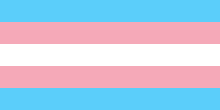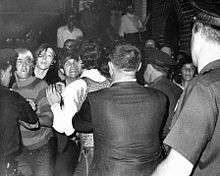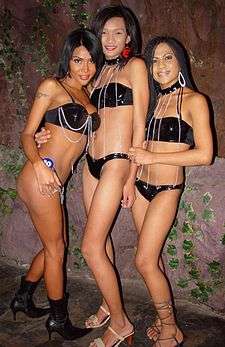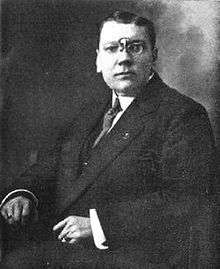Transgender history
| Part of a series on |
| Transgender topics |
|---|
 |
| Identities |
| Topics |
| Attitudes |
| Legal issues |
| Lists |
|
|
Transgender history dates back to the first recorded instances of transgender individuals in ancient civilizations in Asia. Only since the latter half of the twentieth century has there been any awareness and development of a community of transgender individuals.
Ancient history
Transgender and third gender people have been recorded in almost all cultures across human history.
Americas

Prior to western contact, some American Native tribes had third-gender roles, but details were only recorded after arrival of Europeans. Roles included "berdache" (a derogatory term for people assigned male at birth who assumed a traditionally feminine role) and "passing women" (people assigned female at birth who took on a traditionally masculine role). The term "berdache" is not a Native American word; rather it was of European origin and covered a range of third-gender people in different tribes. Not all Native American tribes recognized transgender people.[1]
One of the first accounts of transgender people in the Americas was made by Jesuit missionary Joseph-François Lafitau who spent six years among the Iroquois in 1711.[2] He observed "women with manly courage who prided themselves upon the profession of warrior" as well as "men cowardly enough to live as women."[3]
Asia
In ancient Assyria, there were homosexual and transgender cult prostitutes, who took part in public processions, singing, dancing, wearing costumes, sometimes wearing women's clothes and carrying female symbols, even at times pretending to give birth.[4]
In ancient India, Hijra are a caste of third-gender, or transgender group who live a feminine role. Hijra may be born male or intersex, and some may have been born female.[5] Hijras have a recorded history in the Indian subcontinent from antiquity onwards as suggested by the Kama Sutra period.
In Persia, poets such as Sa'di, Hafiz, and Jami wrote poems replete with homoerotic allusions, including sex with transgender young women or males enacting transgender roles exemplified by the köçeks and the bacchás, and Sufi spiritual practices.
Europe
Ancient Greece

In Ancient Greece and Phrygia, and later in the Roman Republic, the Goddess Cybele was worshiped by a cult of people who castrated themselves, and thereafter took female dress and referred to themselves as female.[6][7] These early transsexual figures have also been referred by several authors as early gay role models.[8][9]
Ancient Rome
Modern period
This covers roughly the period from The Enlightenment to today.
The Americas
Central America
In the Dominican Republic, an intersex trait not uncommon in the town of Las Salinas results in some boys being assigned female and raised as girls. At puberty, they are virilized by male hormones, recognized as boys, and raised henceforth as boys. They are called "guevedoces" (Spanish for "eggs at twelve"). This is a common enough occurrence in town that townspeople take it in stride.[10]
Mexico
In Zapotec cultures of Oaxaca a muxe is an individual assigned male at birth who dresses and otherwise behaves in ways associated with females. They may be seen as a third gender.[11] Muxe may do certain kinds of women’s work such as embroidery but others do the male work of making jewelry.[12][13] One study estimates that six percent of males in an Isthmus Zapotec community in the early 1970s were muxe.[14]
United States of America



There were isolated cases of people living as the opposite sex in the early years of the Republic such as Joseph Lobdell. During the Civil War, over 200 women donned men's clothing and fought as soldiers; some were transgender and lived the rest of their lives as men, such as Albert Cashier.[15]
In 1895 a group of self-described androgynes in New York organized a club called the Cercle Hermaphroditos, based on their wish "to unite for defense against the world's bitter persecution".[16]
A couple of first-person accounts in the early years of the 20th century cast some light on what life for a transgender person was like then, including The Autobiography of an Androgyne (1918) by Jennie June (born in 1874 as Earl Lind).[17] Notable American jazz musician and bandleader Billy Tipton (born in 1914 as Dorothy Lucille Tipton) lived as a man from the 1940s until his death.[18]
The idea of someone changing sex was unknown to most people until news about Christine Jorgensen burst onto the scene in 1952. She was the first widely publicized person to have undergone sex reassignment surgery.[19] Around the same time, organization and clubs began to form, such as Virginia Prince's Tranvestia publication for an international organization of cross-dressers,[20] but this operated in the same shadows as did the still forming gay subculture. In the 1960s, transgender and gay activism began with riots in 1966 at Compton's Cafeteria in San Francisco and in a defining event in gay and transgender activism, the 1969 Stonewall Riots in New York.
The 1970s and 1980s saw organizations devoted to transgender social activities or activism come and go, including activist Lou Sullivan's FTM support group that grew into FTM International, the leading advocacy group for female-to-male transgender individuals.[20] Some feminist and lesbian organizations and individuals began to question whether transgender individuals could be accepted in events designated for one sex only, such as the women's music collective Olivia Records where transwoman Sandy Stone had long been employed, or in the 1990s at the Michigan Womyn's Music Festival which had a women-born-women in policy.
Among Native Americans, the term Two Spirit was adopted in 1994 with general, though not universal agreement among various tribes to refer to third gender or gender-variant individuals in their communities.[21]
The 1990s saw the establishment of Transgender Day of Remembrance to honor those lost to violence, transgender marches and parades around the time of Gay Pride celebrations and increasingly in the 2000s and after, the visibility of transgender individuals rose, along with actresses like Laverne Cox who was on the cover of TIME[22][23][24] and exemplified by Caitlyn Jenner coming out in 2015.[25] Many news sources have described Jenner as the most famous openly transgender American.[26][27][28]
Oganizations such as the Girl Scouts[29] and the Episcopal Church announced acceptance of transgender people[30] in the 2010s. In 2016, the Obama administration issued guidance that directed public schools to let transgender students use bathrooms and locker rooms matching their gender identity,[31] while some legislative bodies took up bills seen as discriminatory, such as North Carolina's HB 2.
Australasia and Oceania
In the Cook Islands, the akava'ine is a Māori Rarotongan word which has become used since the 2000s to refer to transgender people of Māori descent from the Cook Islands. It is a contemporary identity which arose through cross-cultural contact with other Polynesians living in New Zealand, especially the Samoan Fa'afafine.[32]
In Samoa, the Fa'afafine ("in the manner of a woman") are a type of third gender with uncertain origin who go back at least to the beginning of the twentieth century. Fa'afafine are male at birth, and express both masculine and feminine gender traits.[33][34]
Asia
Gulf Arab states
The khanith are a third gender category in Oman and the Arabian Peninsula who function sexually, and in some ways socially, as women.[35]
China
Transgender Studies was only established as an academic discipline in the 1990s so it is difficult to apply transgender to Chinese culture in a historical context. There were no transgender groups or communities in Hong Kong until after the turn of the 21st century. Today they are still known as a "sexual minority" in China.[36] China and greater China (the Chinese region, including People's Republic of China, Hong Kong, Macau and Taiwan (Republic of China)) are characterized by transphobia. .[37]
Indonesia
An all-transgender netball team from Indonesia competed at the 1994 Gay Games in New York City. The team had been the Indonesian national champions.[38]
Iran
Under The Shah transsexuals and crossdressers were classed with gays and lesbians and faced punishment of lashing or even death. The new religious government that came to be established under the Ayatollah treated them initially the same way.
Beginning in the mid-1980s, however, transsexuals were officially recognized by the government and allowed to undergo sex reassignment surgery. As of 2008, Iran carries out more sex change operations than any other nation except Thailand.[39] The government provides up to half the cost for those needing financial assistance, and a sex change is recognized on the birth certificate.[40]
Japan
Transgenderism in Japan began during the Edo period. Women actors were banned from kabuki theatre performances and, in turn, effeminate male performers took on the roles of women. Such actors maintained their dress both inside and outside of the theater. It was widely believed, at the time, that only men could really know what beauty in a woman looked like. Moreover, if a man acted like a woman, dressed like a woman and took on the social roles of a woman, he was simply socialized as one. The latter is a result of how Japan conceptualized gender and sexuality in terms of adopted social roles.
Thailand

Kathoey is a Thai term, often translated as "ladyboy" in modern English, which has undergone an evolution. It used to refer to intersex individuals, then in the 20th century to cross-dressing males or gay men who display varying degrees of femininity which may or may not include hormonal or surgical intervention. In contrast, sao praphet song suggests someone who identifies as a woman.
Toms and Dees are two kinds of female gender identity in Thailand. A "Tom" is a female who dresses, acts, and possibly speaks in a masculine fashion. A "dee" is a homosexual (or bisexual) female who follows typical Thai female gender expression. The only difference between dees and traditional Thai females is that dees engage in relationships with toms.[41] A kathoey, or "ladyboy", refers to a male who dresses as and adopts the mannerisms and identity of a woman.[42]
Thailand has become a center for performing sex reassignment surgery, and now performs more than any other country.[39]
Europe
Balkans
Balkan sworn virgins are women who take a vow of celibacy, wear male clothing, assume male privileges, and live out their lives as men in the patriarchal society of northern Albania. The tradition goes back to a 15th-century code of laws, and is observed by members of different religions.[43] The practice was first reported by missionaries and other travelers who visited the area in the 19th century.[44]
Denmark

Lili Elbe was a Danish transgender woman and one of the first recipients of sex reassignment surgery.[45][46] Elbe was born a male and was a successful painter in that guise.[47] She also presented as Lili (sometimes spelled Lily). She transitioned in 1930 and made a legal name change to Lili Ilse Elvenes[48] and stopped painting. Lili died from complications involving a uterus transplant.[49][50]
Denmark is also known for its role in the transition of American Christine Jorgensen, whose operations were performed in Copenhagen starting in 1951.[51]
Great Britain
Molly houses appeared in 18th century London and other large cities. A Molly house is an archaic 18th century English term for a tavern or private room where homosexual and cross-dressing men could meet each other and possible sexual partners. Patrons of the Molly house would sometimes enact mock weddings, sometimes with the bride giving birth.
Germany

Prior to the Third Reich, Berlin was a liberal city, with many gay bars, nightclubs and cabarets. There were even many drag bars where tourists straight and gay would enjoy female impersonation acts. Hitler decried cultural degeneration, prostitution and syphilis in his book Mein Kampf, blaming at least some of the phenomena on Jews.
Berlin also had the most active LGBT rights movements in the world at the time. Jewish doctor Magnus Hirschfeld had co-founded the Scientific-Humanitarian Committee (Wissenschaftlich-humanitäres Komitee, WhK) in Berlin and sought social recognition of homosexual and transgender men and women. The Committee had branches in several other countries, thereby being the first international GLBT organization, although on a small scale. In 1919, Hirschfeld had also co-founded the Institut für Sexualwissenschaft (Institute for Sex Research), a private sexology research institute. It had a research library and a large archive, and included a marriage and sex counseling office. In addition, the institute was a pioneer worldwide in the call for civil rights and social acceptance for homosexual and transgender people.
The word transvestite was coined by Hirschfeld and used as the title of his 1910 book, The Transvestites: The Erotic Drive to Cross-Dress.
See also
- Fakaleiti
- International Transgender Day of Visibility
- Intersex in history
- LGBT history
- Transgender History - book by Riki Wilchins
References
- ↑ Katz, J. (1976) Gay American History: Lesbians and Gay Men in the U.S.A. New York: Thomas Y. Crowell Company
- ↑ Fenton, William N.; Moore, Elizabeth L. (1969). "J.-F. Lafitau (1681-1746), Precursor of Scientific Anthropology". Southwestern Journal of Anthropology. 25 (2): 174–5. JSTOR 3629200.
- ↑ FitzGerald, Maureen; Rayter, Scott (2012). "4 The Regulation of First Nations Sexuality, by Martin Cannon". Queerly Canadian: An Introductory Reader in Sexuality Studies. Canadian Scholars’ Press. p. 52. ISBN 978-1-55130-400-7. OCLC 801167318. Retrieved 1 July 2016.
- ↑ The Nature Of Homosexuality, Erik Holland, page 465, 2004
- ↑ "Gay and Lesbian Vaishnava Association, Inc". Galva108.org. Retrieved 2013-11-02.
- ↑ Califia, Patrick (2003). Sex Changes The Politics of Transgenderism. California: Cleis Press, Inc. ISDN 1-57344-180-5
- ↑ Benjamin, H. (1966). The Transsexual Phenomenon. New York: Julian Press.
- ↑ Evans, Arthur (1978). Witchcraft and the Gay Counterculture. Boston: Fag Rag Books.
- ↑ Conner, R. (1993). Blossom of Bone: Reclaiming the Connections between Homoeroticism and the Sacred. San Francisco: Harper.
- ↑ Mosley, Michael. "The extraordinary case of the Guevedoces". BBC News. BBC News. Retrieved 23 September 2015.
- ↑ Chiñas, Beverly (1995). Isthmus Zapotec attitudes toward sex and gender anomalies, pp. 293-302 in Stephen O. Murray (ed.), "Latin American Male Homosexualities" Albuquerque: University of New Mexico Press.
- ↑ Stephen, Lynn (2002). "Latin American Perspectives," Issue 123, Vol.29 No.2, March 2002, pp. 41-59. Sexualities and Genders in Zapotec Oaxaca.
- ↑ MIANO, M. (2002). Hombre, mujer y muxe’ en el Istmo de Tehuantepec. México: Plaza y Valdés. CONACULTA-INAH.
- ↑ Rymph, David (1974). Cross-sex behavior in an Isthmus Zapotec village. Paper presented at the annual meeting of the American Anthropological Association, Mexico City.
- ↑ "TransActive - Transgender History: People & Cultures". Transactiveonline.org. Retrieved May 15, 2012.
- ↑ Pareene, Alex. "Why the T in LGBT is here to stay - LGBT". Salon.com. Retrieved May 15, 2012.
- ↑ "Earl Lind (Ralph Werther-Jennie June): The Riddle of the Underworld, 1921". OutHistory. Retrieved May 15, 2012.
- ↑ Lehrman, Sally (May–June 1997). "Billy Tipton: Self-Made Man". Stanford Today Online. Retrieved February 1, 2007.
- ↑ John T. Mcquiston. "Christine Jorgensen, 62, Is Dead; Was First to Have a Sex Change - New York Times". Nytimes.com. Retrieved July 25, 2014.
- 1 2 Stryker, Susan. "Transgender Activism" (PDF). glbtq archives. glbtq. Retrieved February 6, 2016.
- ↑ Medicine, Beatrice (August 2002). "Directions in Gender Research in American Indian Societies: Two Spirits and Other Categories". Online Readings in Psychology and Culture. International Association for Cross-Cultural Psychology. 3 (1): 7. doi:10.9707/2307-0919.1024. ISSN 2307-0919. Archived from the original on 2012-12-08. Retrieved 2016-06-25.
At the Wenner Gren conference on gender held in Chicago, May, 1994... the gay American Indian and Alaska Native males agreed to use the term "Two Spirit" to replace the controversial "berdache" term. The stated objective was to purge the older term from anthropological literature as it was seen as demeaning and not reflective of Native categories. Unfortunately, the term "berdache" has also been incorporated in the psychology and women studies domains, so the task for the affected group to purge the term looms large and may be formidable.
- ↑ Levenson, Eric (May 29, 2014). "Laverne Cox Is the First Transgender Person on the Cover of Time". The Wire. Retrieved February 4, 2016.
- ↑ Katy Steinmetz. "The Transgender Tipping Point". TIME. Retrieved June 29, 2014.
- ↑ Myles Tanzer. "Laverne Cox Is On The Cover Of Time Magazine". Buzzfeed.com. Retrieved June 29, 2014.
- ↑ Buzz Bissinger (June 1, 2015). "Introducing Caitlyn Jenner". Vanity Fair. Retrieved June 1, 2015.
- ↑ Milliken, Mary (April 25, 2015). "Olympian Bruce Jenner makes transgender history by identifying as a woman". Reuters. Retrieved April 26, 2015.
- ↑ "Bruce Jenner on living as a woman". BBC News. April 25, 2015. Retrieved April 26, 2015.
- ↑ Ford, Matt (April 25, 2015). "Bruce Jenner, Transgender American". The Atlantic. Retrieved April 26, 2015.
- ↑ "Transgender children welcomed by the Girl Scouts of America". Imperfectparent.com. October 26, 2011. Retrieved November 6, 2012.
- ↑ Kaleem, Jaweed (July 9, 2012). "Episcopal Church Takes Bold Step On Transgender Priests". Huffington Post.
- ↑ Emanuella Grinberg, CNN (May 13, 2016). "White House issues guidance on transgender bathrooms - CNNPolitics.com". CNN.
- ↑ "Story: Gender diversity Page 3 – Fa'afafine".
- ↑ Schmidt, Johanna (2015-09-22). "Story: Gender diversity Page 3 – Fa'afafine". Archived from the original on 2013-07-03. Retrieved 2016-06-21.
- ↑ Bartlett, N H.; Vasey, P. L. (2006). "A Retrospective Study of Childhood Gender-Atypical Behavior in Samoan Fa'afafine". Archives of Sexual Behavior. 35 (6): 659–66. doi:10.1007/s10508-006-9055-1. PMID 16909317.
- ↑ Haggerty, George (5 November 2013) [1st pub. 2000]. Encyclopedia of Gay Histories and Cultures. New York: Routledge. pp. 515–516. ISBN 978-1-135-58506-8. OCLC 909323355. Retrieved 3 July 2016.
- ↑ Chiang, Howard. Transgender China. New York: Palgrave MacMillan. p. 269. ISBN 978-0-230-34062-6.
- ↑ Chiang, Howard (2012). Transgender China. New York: Palgrave MacMillan. p. 8. ISBN 978-0-230-34062-6.
- ↑ Altman, Dennis (2001). "Global Gaze / Global Gays". In Blasius, Mark. Sexual identities, queer politics. University Press. p. 100. ISBN 0-691-05866-0. OCLC 439890293.
- 1 2 "Sex change funding undermines no gays claim", Robert Tait, The Guardian, 26 September 2007; accessed 20 September 2008.
- ↑ Barford, Vanessa (February 25, 2008). "BBC News: Iran's 'diagnosed transsexuals'". British Broadcasting Corporation. Retrieved March 12, 2012.
- ↑ Wilson, Ara (July 2004). The Intimate Economies of Bangkok: Economies of Bangkok Tomboys, Tycoons, and Avon Ladies in the Global City. Berkeley: University of California Press. ISBN 9780520239685.
- ↑ Winter, Sam; Udomsak, Nuttawut (2002). "Male, Female and Transgender : Stereotypes and Self in Thailand". International Journal of Transgenderism. 6 (1). ISSN 1434-4599. Retrieved 29 November 2015.
- ↑ Becatoros, Elena (October 6, 2008). "Tradition of 'sworn virgins' dying out in Albania". Die Welt. Archived from the original on 2008-10-26. Retrieved 2016-07-18.
- ↑ Elsie, Robert (2010). Historical Dictionary of Albania. Historical dictionaries of Europe (2nd ed.). Lanham: Scarecrow Press. p. 435. ISBN 978-0810861-88-6.
- ↑ Hirschfeld, Magnus. Chirurgische Eingriffe bei Anomalien des Sexuallebens: Therapie der Gegenwart, pp. 67, 451–455
- ↑ Lili Elbe. andrejkoymasky.com. 17 May 2003
- ↑ Meyer, Sabine (2015), »Wie Lili zu einem richtigen Mädchen wurde« – Lili Elbe: Zur Konstruktion von Geschlecht und Identität zwischen Medialisierung, Regulierung und Subjektivierung, p. 15, pp. 312-313.
- ↑ (Meyer 2015, pp. 311–314)
- ↑ "Lili Elbe Biography". Biography.com. A&E Television Networks. Retrieved December 11, 2015.
- ↑ "Lili Elbe: the transgender artist behind The Danish Girl". This Week Magazine. 18 September 2015. Retrieved 1 February 2016.
- ↑ "21 Transgender People Who Influenced American Culture". Time Magazine. May 29, 2014.

